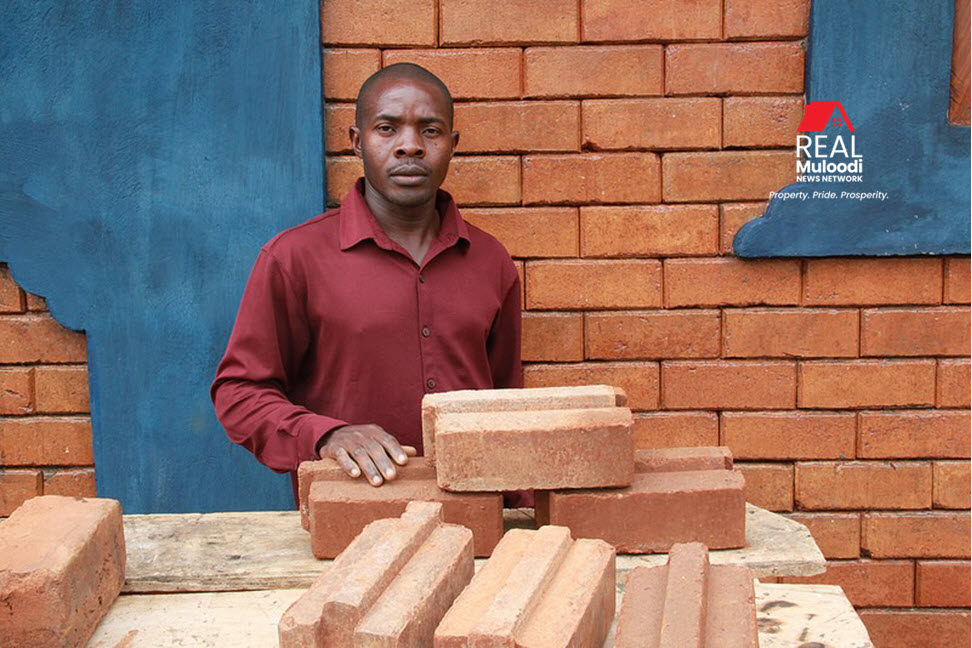UGANDA, Kampala | Real Muloodi News | The construction industry in Uganda is facing a crisis as the cost of cement continues to rise. This has led many property developers to look for alternative building materials that can help to reduce costs without compromising on quality. One such alternative is Interlocking Stabilised Soil Blocks (ISSBs).
ISSBs are a type of compressed stabilised earth block that interlock with each other. They are made from a mixture of soil, cement, and water that is compacted under high pressure using a manual or mechanical press. These blocks use significantly less cement than traditional bricks and concrete blocks.

One of the key benefits of ISSBs is that they are made from locally available soil, which is often free. The production process is relatively simple and can be done on-site, reducing transportation costs.
Unlike traditional burned bricks which require the costly process of firing clay at high temperatures and consuming large amounts of wood, ISSBs are left to cure for a few days before construction, resulting in less environmental impact and making them a more sustainable housing solution.
Additionally, traditional burned bricks are often uneven in size, requiring up to 3 centimeters of cement between each brick, which increases the final building cost significantly. ISSBs, on the other hand, require 83% less mortar between bricks since they interlock in both the horizontal and vertical directions. This results in significant cost savings during construction and improves the stability of the overall structure. They also don’t require masonry skills to lay the blocks, making them accessible to a wider range of builders.
ISSBs are also durable and can withstand extreme weather conditions, making them suitable for use in a variety of construction applications. They have been found to have similar or even better strength characteristics than traditional bricks.

As Uganda’s population continues to grow, the need for affordable and sustainable housing solutions becomes increasingly important. Interlocking Stabilised Soil Blocks have gained recognition as a solution to this need.
History of ISSBs
The concept of making blocks by compacting earth or mixing it with stabilising supplements, such as cement, is an old idea dating back thousands of years. However, a key step in the evolution of this technology occurred in the early 1990s thanks to Eng. Dr Moses Musaazi (deceased), a Ugandan engineer and professor from Makerere University.
Dr. Musaazi was inspired to develop a more sustainable and affordable building solution for the country, as traditional brick and cement construction methods were costly and environmentally damaging. In 1993, he built a double-storey house in Kawempe from rectangular compressed stabilised earth blocks made using a manual press machine.
Although the house was successful, Dr. Musaazi realised that he still needed to use significant amounts of cement for mortar, which kept the cost of construction high. He therefore approached various manufacturers of the press machine, explaining that he wanted to change the design so that the blocks could interlock, eliminating the need for cement mortar during construction.
Eventually, he got in touch with a company in Kenya called Makiga, which bought his idea and made him a machine to suit his specification, with blocks that could interlock from the front and back. This was the birth of the first interlocking block machine in Uganda and in the East African region.

Using the machine, Dr. Musaazi built rental houses in Kawempe with interlocking stabilised soil blocks. He also contracted several buildings at Makerere University, to demonstrate that it was possible to build strong structures using blocks.
Although the rentals and the buildings at the university were successful, Dr. Musaazi felt he needed to make some improvements to the machine. He then developed a double interlocking machine.
The double interlocking machine, known as the “Musaazi double interlocking machine”, is designed to create blocks with interlocks on both the top and bottom surfaces, as well as the front and back. This double interlocking system improved the strength and stability of the blocks, allowing for the construction of more durable and sustainable buildings.
The machine is operated manually and it compresses soil mixed with cement and water into blocks using a hydraulic press. The blocks are then removed from the machine and left to dry before they are used in construction. The machine can produce different sizes of blocks depending on the needs of the project.
The double interlocking machine is considered more efficient than traditional manual methods of making ISSBs, as it can produce a greater number of blocks in a shorter amount of time. It also allows for more consistency in the size and shape of the blocks, which improves the overall quality of the construction.
Dr. Musaazi’s double interlocking system has been widely adopted in Uganda and other countries in Africa, and has been used in a variety of construction projects, including housing, schools and health clinics, particularly in rural areas where access to traditional building materials is limited.
Dr. Musaazi’s work has been recognised internationally, and he received several awards and honours for his contributions to sustainable housing and construction in Uganda and Africa.
In Part 2 of this series, we explore how to make Interlocking Stabilised Soil Blocks, and where you can buy a “Musaazi double interlocking machine.” CLICK HERE FOR PART 2….
READ MORE LIKE THIS:
Cement Prices Rise as Factory Operations are Hindered by Severe Blackouts




